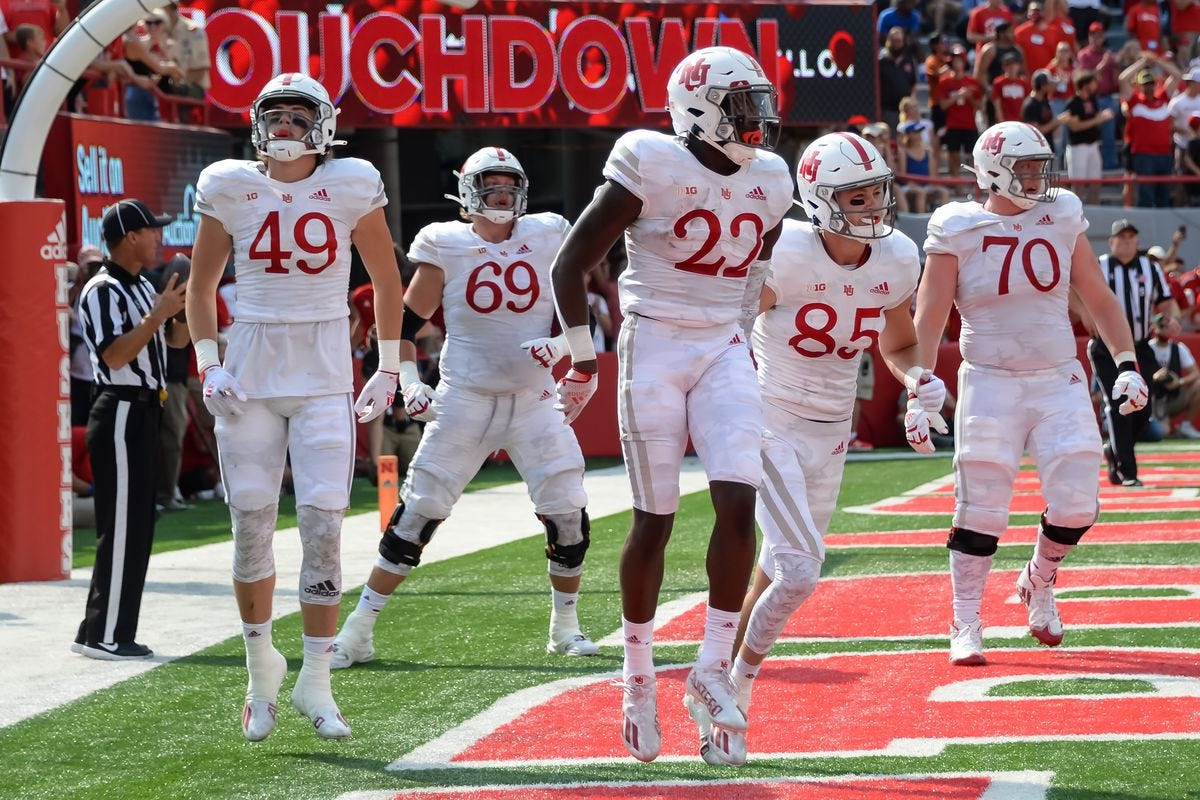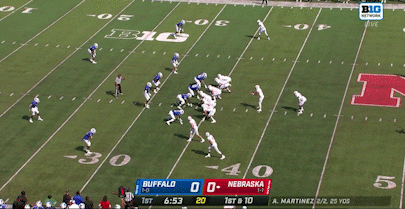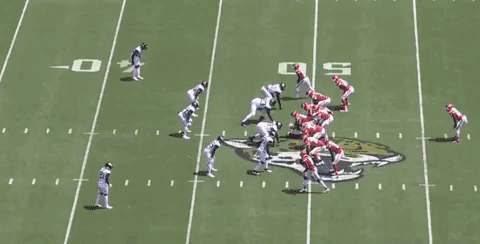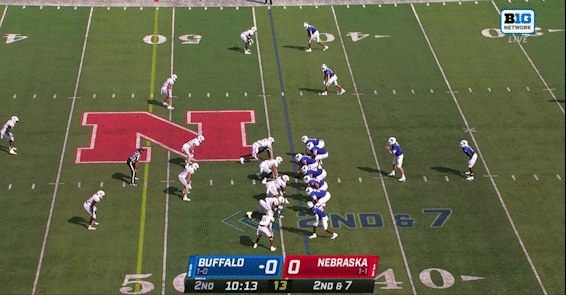BUFFALO RECAP: Reasons To Be Bullish?
NU has rebounded the last two weeks. Now we'll see if they can take another step, plus a schematic and statistical breakdown of the Buffalo game
After a week off for a HARROWING CROSS-COUNTRY MOVE, the newsletter is BACK!
Following the season-opening loss to Illinois (which is looking more embarrassing by the week and actively making my brain numb), I said there was some fairly compelling evidence the Illini L was fluky and I could still buy progress within the program if NU looked impressive against Fordham and Buffalo.
And, aside from a couple slow starts and some TRULY DREADFUL SPECIAL TEAMS, that’s essentially what’s happened. In those two games, Nebraska cumulatively averaged 7.31 yards per play while allowing 4.55 with no offensive turnovers and four takeaways forced. Adrian Martinez has been one of the country’s best QBs in that span. The Huskers SP+ ranking is back to exactly where it was at the start of the season. If you wanted a reset, that’s a reset.
That’s not to say everything has been completely promising. The pass blocking has been atrocious, especially against the Bulls. The offense has been dependent on a quarterback who could reasonably described as injury prone and is getting hit 15 times a game. The special teams have been … well, the special teams.
But the first step to any semblance of salvaging a successful season and showing real progress after Week 0 was to handle the past two weeks in convincing fashion. For whatever it’s worth, they’ve done that. The next step — showing you can be competitive against the nation’s best — will be decidedly harder.
OFFENSE
OFFENSIVE GAME CHART:
Google Sheet link HERE
Downloadable PDF link HERE
STATISTICS:
YARDS PER PLAY: 8.32 Yards Per Play
Pregame Season Average: 5.2 yards per play (NCAA rank: 51st)
National Median: 5.2 yards per play (Stats and rankings only counting FBS games)
POINTS PER DRIVE: 2.33 Points Per Drive
Pregame Season Average: 3.28 points per drive
EXPLOSIVE PLAYS: 8 Explosive Plays (Pass: 6, Run: 2)
Pregame Season Average: 9.5 explosive plays
HAVOC PLAYS ALLOWED: 5 Havoc Plays Allowed (8.20 percent of plays)
Pregame Season Average: 6 Havoc plays allowed
OVERVIEW:
A lot was made about Nebraska’s lack of sustained success and reliance on big plays this game. And I guess that is concerning, to a degree — NU has to be able to run the ball with its backs when it needs to against the better defenses in the Big Ten, and relying on Martinez to pull rabbits out of hats at this rate is unsustainable. But I’m a little less worried than the consensus. One, coach Scott Frost’s offense was reliant on big plays at both Oregon and Central Florida and wasn’t really stringing 10-play drives together. It’s just sort of how his scheme has always operated; you trade-off chunk plays for a few more three-and-outs. The yards and points still count the same. And second, Buffalo is the best front they’ve played thus far and will probably better against the run than at least a few of the Big Ten teams on NU’s remaining schedule.
An actual BIG reason to be concerned is the offensive line. After it played well against an overmatched and undersized Fordham front, the pass blocking was unbelievably against the Bulls, both by the eye test and by the numbers. NU’s pass blocking collectively graded out by PFF at 22.8, and that number is buoyed by another excellent game from Cam “BEEF JURGY” Jurgens (75.7). The Huskers’ four other starters all graded out under 30 (a grade around 60 is considered average) and allowed a collective 13 pressures in a game that saw Nebraska only have 10 total true pass sets. Freshman left tackle Turner Corcoran had a ***1.3*** GRADE as a pass blocker. If not for Martinez’s legs bailing them out of sacks and pressures, this passing game would be completely dysfunctional right now. The Bulls do have a pretty good front full of small, quick guys designed to get penetration, but if you’re having trouble with Buffalo, what’s going to happen against OU, Ohio State, Iowa, Michigan, and Wisconsin later this year? Many in the offseason thought the o-line might make a big leap, but so far it’s been the clear weakness of the team.
And while we’re on the subject, shoutout to Adrian Martinez. Since a bad second quarter against Illinois, he’s played like one of the best quarterbacks in the country:


This dude is playing out of his mind right now. I saw a lot of LAME Husker fans calling for him to be benched after Illinois, but Adrian has done nothing but come out and set defenses on fire since that point. He’s turning plays that would be sacks and throw aways to most quarterbacks into monster gains on the reg. The book on him the past two years has been that he can be competent with good players around him but was never transcendently good to make up for others’ mistakes. Well, he’s doing it right now. As he seems like a genuinely pretty good dude who has gotten a lot of unnecessary grief from Husker fans, it’s pretty good to see.
General notes, with an on-field temperature that went over 130 degrees, NU unsurprisingly utilized tempo at its lowest percentage so far this season, on only 55 percent of its snaps. The run-pass balance ended up about 60-40, though that was with some garbage time included. It seemed like it might go even higher than that after the first half, but NU opened up with some more passing after the break.
Schematically, One thing to watch for the future the running game was the utilization of wide receiver lead blocks, especially after motion. Twelve of Nebraska’s 36 designed runs Saturday used a WR lead tag. It’s an add-on to all of NU’s staple running concepts — Nebraska used it with inside and outside zone, power, and counter against the Bulls. They also used it quite a bit in the Fordham game. If it’s a trend that continues I’ll do a more in-depth breakdown in a later newsletter.
HUSKERS EMPTY THE CLIP ON COVER 0:
Twice in the first half Saturday Nebraska came out in an empty look out of its base 11 personnel after using tempo, and twice Buffalo matched by playing Cover 0. Here’s how both of those plays turned out:


The zero in Cover 0 refers to the number of safeties deep; it’s true one-on-one, man-to-man coverage. No help. It’s an aggressive, risky strategy typically used when a team wants to bring a big blitz — because it knows with the pressure the ball will come out fast and not expose its coverage players long enough to get beat deep — but Buffalo used it to keep two defenders in short underneath zones, presumably to cover short routes and “spy” Martinez to prevent a scramble. Watch how in the first video the two circled defenders below simulate coming on pressure before dropping back and looking for routes, while the man defenders immediately lock onto their defenders:

There’s no one deep to cover any mistakes or help on either of these plays. On the long run, after Martinez breaks out of the sack and the spy to the field gambles on getting a sack and gets blocked, there are no defenders with eyes on Martinez, as the man defenders are focused on their receivers. On the long pass, after the Buffalo corner gets eviscerated by Samori Toure’s SICK AS HELL release on his Y-Cross route, it’s basically just a foot race.
Those two plays were the only time the Bulls utilized this look, so I’m assuming it was their check against empty formations. But Buffalo made a bet that it’s secondary could cover NU’s wideouts one-on-one down the field, and Nebraska made them pay for it. It’s been a while since that happened!
A COOL PLAY:
GF Counter Leak
‘Leak’ has been the NFL play du jour for the past couple seasons, famously used by Kyle Shanahan, Sean McVay, and Andy Reid (GO CHIEFS) as a downfield shot play. Leak is a form of play action boot pass, designed to take advantage of a defense playing the outside run too hard. It has a typical typical boot action to the play side, but a condensed player (usually a tight end) blocks for a second before releasing on a flat pass route against the grain that turns up the sideline. Below is a diagram of the play from Shanahan’s 49ers playbook (photo credit to Ted Nguyen’s excellent breakdown of the play on The Athletic last year.
With the defense flowing to what it thinks is a typical boot pass, no one ever notices the tight end sneaking out the back. This is one of those magic plays that always seems to be absolutely wide open. Except when Nebraska runs it:
Here, Nebraska calls Leak off a counter look with the guard and the H-back on its opening drive. The Huskers ran “GF Counter” (as opposed to a Guard-Tackle GT Counter) on their first play of the game to get Buffalo thinking about it, then called this Leak action off of it five snaps later. Check out the play sequencing in the offensive chart sheet.
To be fair, this came after what seems like NU’s 97th tight end injury of the season and a lost Buffalo defender basically stumbles in to making the tackle, but I’m just saying that it looks a lot different when Nate Boerkircher runs this concept as opposed to when the K.C. Chiefs run it:
(Chiefs .gif courtesy of this post on the Chief in the North newsletter by Seth Keyser, which you should subscribe to) (Also GO CHIEFS).
DEFENSE
DEFENSIVE GAME CHART:
Google Sheet link HERE
Downloadable PDF link HERE
STATISTICS:
YARDS PER PLAY ALLOWED: 4.22 Yards Per Play Allowed
Pregame Season Average: 4.7 yards per play allowed (NCAA rank: 32nd)
National Median: 5.2 yards per play allowed (Stats and rankings only counting FBS games)
POINTS PER DRIVE ALLOWED: 0.21 Points Per Drive Allowed
Pregame Season Average: 2.62 points per drive allowed
HAVOC PLAYS: 16 Havoc Plays (18.8 percent of plays)
Pregame Season Average: 9.5 Havoc plays
EXPLOSIVE PLAYS ALLOWED: 5 Explosive Plays Allowed (Pass: 2, Run: 3)
Pregame Season Average: 6 explosive plays allowed
OVERVIEW:
Saturday was not only the best defensive performance by NU of the Frost era, it was the highest graded performance of any Nebraska defense since PFF started charting college games in 2014, elite against both the run and pass. It’s difficult to overstate how well the Blackshirts played against the Bulls.
Buffalo, even as a MAC team, is one of the best rushing units in the country, using its physicality and discipline to churn out chunks of yardage, control the clock, and take the air out of games. But Nebraska’s defensive line not only stonewalled the Bulls’ offensive line on its zone plays, but was able to get consistent penetration, especially off the edge and backside (more on that later), leading to 6 total tackles for loss and keeping UB off schedule. All three of Buffalo’s runs of 12 or more yards came on cutbacks — good individual plays by the Bulls’ running backs. Not able to play to their strength and in an unfavorable game script, Buffalo’s below-average passing offense was forced into 50 attempts.
ABSOLUTE MANIAC LUKE REIMER played an incredible game by the eye test and the numbers, and was rewarded with Big Ten defensive player of the week.
He missed just one tackle in 18 attempts and was excellent in coverage, allowing just one catch for two yards on four targets — the fourth-down stop was Buffalo’s only completion against him — and an interception. Illinois and Fordham both picked on NU’s middle linebackers in the passing game, so Reimer being solid against the pass would be a big development. Deontai Williams, Damion Daniels, Caleb Tannor, Garrett Nelson, and Pheldarius Payne also continued to show an improved level of play from last year, and overall, 11 of NU’s 14 rotation players graded out as 70 or better by PFF.
After two pretty strong games to open the year, the pass rush looked like its old self against UB. Buffalo does have a good line, but if there’s one thing that could hold this defense back from being one of the elite units in the country, it’s the lack of an excellent one-on-one pass rusher. Another thing to watch is that Cam Taylor-Britt has continued to be … pretty average? Giving up short completions in man isn’t that concerning and he’s always been a risk-reward player. But he’s also taken some pretty baffling chances so far this year, and doesn’t have a lot to show for it. On the 3rd down before Reimer’s interception where UB was backed into its own endzone, he went for an unlikely interception instead of just allowing a short completion and rallying to tackle to force a punt. This isn’t really the level of play Nebraska should be getting from a preseason All-Big Ten corner, but CTB is a CERTIFIED DUDE and I expect him to rebound.
Trend-wise, NU played its 2-5 Nickel look on 87 percent of its snaps. Not super unexpected considering the amount of 11 personnel Buffalo plays, but it’s also becoming pretty clear that the 2-5 Nickel group, with two defensive linemen, two middle linebackers, two outside linebackers, and JoJo Domann moving around as a chess piece wrecking stuff is Nebraska’s best offensive alignment. A more detailed look at the 2-5 Nickel personnel can be found in the Illinois recap.
The Huskers also played a ton of Cover 3 and Cover 1 against UB — on at least 80 percent of their snaps — presumably to get an extra man in the box against run-heavy Buffalo. Even when they came out in two-high safety looks, they rotated down into one of the two.
BOUNDARY RUN BLITZES BY THE SECONDARY:
One specific thing Nebraska did against Buffalo was to bring boundary pressures from secondary players to help in the run game. Against doubles formations, they fired the boundary safety, and against trips, they fired the boundary corner. Here’s what both look like:
DOUBLES (BOUNDARY SAFETY):
TRIPS (BOUNDARY CORNER):
The “boundary” side is the less-wide side of the field between the sideline and the hash where the ball is currently spotted. “Boundary” and “field” sides are more impactful in college because of the width of the hash creates more extremes.
Nebraska brought a boundary pressure from a secondary player on 12 of its 70 non-garbage time offensive snaps, and defensive coordinator Erik Chinander made the adjustment to do so at a higher rate from the second quarter and on. Bringing a run blitz from the boundary side is useful because it gives you an extra run defender should the offense run into the blitz and a player running full speed to track down a run on the backside should they run away from you. It’s even better when the backside player is a good athlete like a secondary player. If you noticed, most of Nebraska’s TFLs Saturday came with the playside defensive line holding up the offensive line on a zone play, forcing the running back to move laterally, while a maniac coming running in from the backside tracks him down. Garrett Nelson is especially good at this.
WRAP-UP
The last two games have been the two highest overall PFF game grades of the Frost era. SP+ says Nebraska has played like the 31st best team in the country. At the very least, NU has proven in the last two weeks that things weren’t nearly as bad as they seemed after the Week 0 loss to Illinois.
But those results have come against two of the worst teams on the schedule (even if Buffalo is completely decent). It remains to be seen if NU actually can back up the progress it’s shown against an actually good team, or if this was just a blip of good play against some meh teams. They’ll get the chance this weekend when juggernaut OU comes to town.
GBR












